Situated in a typical London square, this beautiful townhouse has seen many eras and epochs come and go. Built in Georgian style during the early 1800s, the house has remained a family residence throughout the generations. As with the other houses on the square, it enjoys access to the shared central garden as well as sharing the unremitting noise of London traffic with its neighbours.
London townhouses were built during a quieter, less frenetic, more socially rigid time. The division between classes can be seen in the townhouse’s fenestration; with sleeping quarters for servants behind small attic windows, whilst kitchen and utility rooms were down in the basement with windows below street level. The largest, most elegant rooms with their lofty windows were reserved for the family and guests.
 Changes in the sound landscape within London
For the first two hundred years of a typical London townhouse’s existence, the only noise the residence would be subjected to from the streets would be the occasional carriage and the rural sounds of sheep/cattle. Gradually over the centuries, London has morphed into the great metropolis of the current day. Situated slap bang in the middle of the busiest areas in London these once tranquil squares now suffer from significant noise pollution.
The beautiful Georgian style double sash windows, so characteristic of the townhouse, are no defence against 21st century urban noise. By their very nature sash windows are designed to be able to move, so there needs to be space between the sashes and within their sash-box. Noise can, therefore, pass straight through these spaces; whilst the single glazed panes and thin transoms provide very little noise attenuation.
The owner of this particular property was converted to the benefits and aesthetic properties of secondary glazing whilst staying at a London hotel and experiencing the difference it can make first-hand; so contact was made with Selectaglaze to design a suitable treatment for the windows. The caveat, however, was that the homeowner would only accept a treatment that wouldn’t impact on the operation of the original shutters. Amazingly two types of shutter had survived over the centuries, both in excellent condition; one folding and one sliding which both needed to be accommodated by the potential treatment.
Changes in the sound landscape within London
For the first two hundred years of a typical London townhouse’s existence, the only noise the residence would be subjected to from the streets would be the occasional carriage and the rural sounds of sheep/cattle. Gradually over the centuries, London has morphed into the great metropolis of the current day. Situated slap bang in the middle of the busiest areas in London these once tranquil squares now suffer from significant noise pollution.
The beautiful Georgian style double sash windows, so characteristic of the townhouse, are no defence against 21st century urban noise. By their very nature sash windows are designed to be able to move, so there needs to be space between the sashes and within their sash-box. Noise can, therefore, pass straight through these spaces; whilst the single glazed panes and thin transoms provide very little noise attenuation.
The owner of this particular property was converted to the benefits and aesthetic properties of secondary glazing whilst staying at a London hotel and experiencing the difference it can make first-hand; so contact was made with Selectaglaze to design a suitable treatment for the windows. The caveat, however, was that the homeowner would only accept a treatment that wouldn’t impact on the operation of the original shutters. Amazingly two types of shutter had survived over the centuries, both in excellent condition; one folding and one sliding which both needed to be accommodated by the potential treatment.
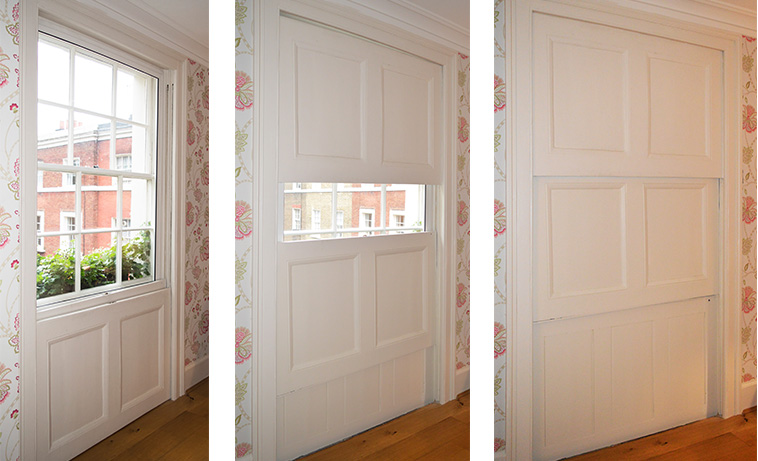 Sliding shutters with secondary glazing
Sliding shutters with secondary glazing
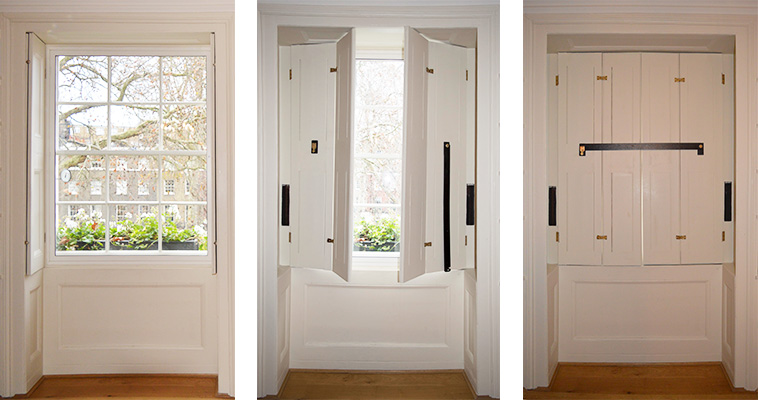 Hinged folding shutters with secondary glazing
Selectaglaze has designed a wide range of products which blend with historic environments whilst providing significant noise attenuation. This treatment was particularly challenging but the undeterred and experienced Technical Advisor designed a solution which was able to accommodate all the requirements.
Hinged folding shutters with secondary glazing
Selectaglaze has designed a wide range of products which blend with historic environments whilst providing significant noise attenuation. This treatment was particularly challenging but the undeterred and experienced Technical Advisor designed a solution which was able to accommodate all the requirements.
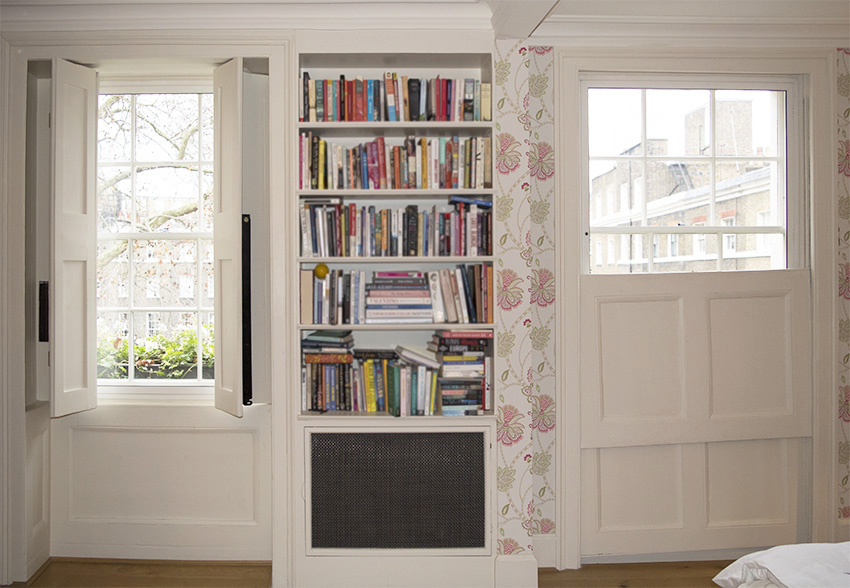 Seemingly symmetrical Georgian sash windows, with two types of shutter systems
Two bespoke Series 45 hinged casement units were manufactured to fit exactly into the two openings. Although symmetrical, their actual dimensions were slightly different with window one 3mm wider and 1 mm taller than window two. An optimal fit is important as even a slight disparity between the opening and the secondary unit can impact negatively on the resulting acoustic benefit of the whole treatment.
Seemingly symmetrical Georgian sash windows, with two types of shutter systems
Two bespoke Series 45 hinged casement units were manufactured to fit exactly into the two openings. Although symmetrical, their actual dimensions were slightly different with window one 3mm wider and 1 mm taller than window two. An optimal fit is important as even a slight disparity between the opening and the secondary unit can impact negatively on the resulting acoustic benefit of the whole treatment.
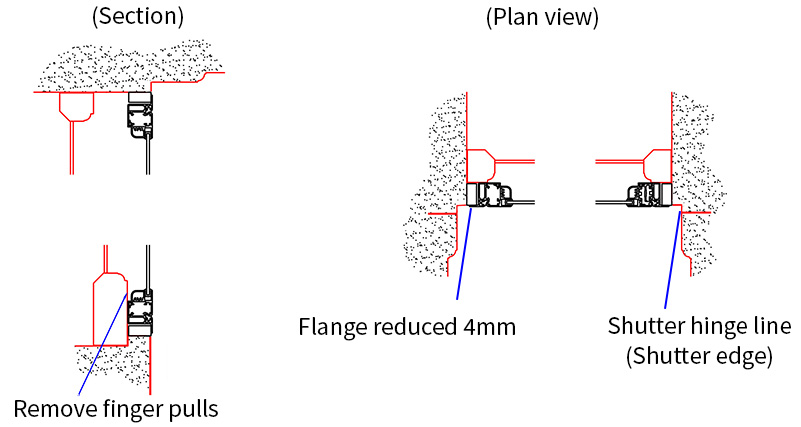 Installation requirements to insure fully functional original shutters after secondary glazing treatment
Due to the original placement of both the folding and sliding shutters Selectaglaze was able, with a few minor adjustments, to fit its Series 45 slimline hinged casement within the cavity. These adjustments involved removing the finger pulls, replacing the existing staff-beads and trimming 4mm off the flanges of the secondary frame.
As the property is Grade II Listed, the addition of secondary glazing required Listed Building Consent. The owners were very grateful to Selectaglaze for supporting them through the application process, which was subsequently accepted, allowing the proposed secondary glazing treatment to be installed.
Installation requirements to insure fully functional original shutters after secondary glazing treatment
Due to the original placement of both the folding and sliding shutters Selectaglaze was able, with a few minor adjustments, to fit its Series 45 slimline hinged casement within the cavity. These adjustments involved removing the finger pulls, replacing the existing staff-beads and trimming 4mm off the flanges of the secondary frame.
As the property is Grade II Listed, the addition of secondary glazing required Listed Building Consent. The owners were very grateful to Selectaglaze for supporting them through the application process, which was subsequently accepted, allowing the proposed secondary glazing treatment to be installed.
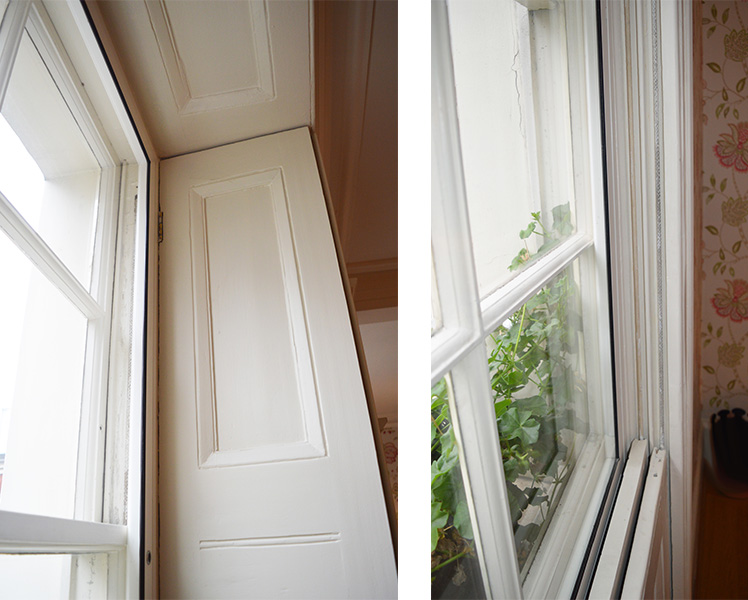 Series 45 HC with 6.8 mm acoustic laminate glass – snug between primary and original shutters
21st century secondary units holding 6.8mm acoustic laminate glass nestle snugly and unobtrusively between the 18th century Baltic pine primary box sash windows and their fully operational shutters. Whilst the resulting noise attenuation is dramatic!
Series 45 HC with 6.8 mm acoustic laminate glass – snug between primary and original shutters
21st century secondary units holding 6.8mm acoustic laminate glass nestle snugly and unobtrusively between the 18th century Baltic pine primary box sash windows and their fully operational shutters. Whilst the resulting noise attenuation is dramatic!
 Changes in the sound landscape within London
For the first two hundred years of a typical London townhouse’s existence, the only noise the residence would be subjected to from the streets would be the occasional carriage and the rural sounds of sheep/cattle. Gradually over the centuries, London has morphed into the great metropolis of the current day. Situated slap bang in the middle of the busiest areas in London these once tranquil squares now suffer from significant noise pollution.
The beautiful Georgian style double sash windows, so characteristic of the townhouse, are no defence against 21st century urban noise. By their very nature sash windows are designed to be able to move, so there needs to be space between the sashes and within their sash-box. Noise can, therefore, pass straight through these spaces; whilst the single glazed panes and thin transoms provide very little noise attenuation.
The owner of this particular property was converted to the benefits and aesthetic properties of secondary glazing whilst staying at a London hotel and experiencing the difference it can make first-hand; so contact was made with Selectaglaze to design a suitable treatment for the windows. The caveat, however, was that the homeowner would only accept a treatment that wouldn’t impact on the operation of the original shutters. Amazingly two types of shutter had survived over the centuries, both in excellent condition; one folding and one sliding which both needed to be accommodated by the potential treatment.
Changes in the sound landscape within London
For the first two hundred years of a typical London townhouse’s existence, the only noise the residence would be subjected to from the streets would be the occasional carriage and the rural sounds of sheep/cattle. Gradually over the centuries, London has morphed into the great metropolis of the current day. Situated slap bang in the middle of the busiest areas in London these once tranquil squares now suffer from significant noise pollution.
The beautiful Georgian style double sash windows, so characteristic of the townhouse, are no defence against 21st century urban noise. By their very nature sash windows are designed to be able to move, so there needs to be space between the sashes and within their sash-box. Noise can, therefore, pass straight through these spaces; whilst the single glazed panes and thin transoms provide very little noise attenuation.
The owner of this particular property was converted to the benefits and aesthetic properties of secondary glazing whilst staying at a London hotel and experiencing the difference it can make first-hand; so contact was made with Selectaglaze to design a suitable treatment for the windows. The caveat, however, was that the homeowner would only accept a treatment that wouldn’t impact on the operation of the original shutters. Amazingly two types of shutter had survived over the centuries, both in excellent condition; one folding and one sliding which both needed to be accommodated by the potential treatment.
 Sliding shutters with secondary glazing
Sliding shutters with secondary glazing
 Hinged folding shutters with secondary glazing
Selectaglaze has designed a wide range of products which blend with historic environments whilst providing significant noise attenuation. This treatment was particularly challenging but the undeterred and experienced Technical Advisor designed a solution which was able to accommodate all the requirements.
Hinged folding shutters with secondary glazing
Selectaglaze has designed a wide range of products which blend with historic environments whilst providing significant noise attenuation. This treatment was particularly challenging but the undeterred and experienced Technical Advisor designed a solution which was able to accommodate all the requirements.
 Seemingly symmetrical Georgian sash windows, with two types of shutter systems
Two bespoke Series 45 hinged casement units were manufactured to fit exactly into the two openings. Although symmetrical, their actual dimensions were slightly different with window one 3mm wider and 1 mm taller than window two. An optimal fit is important as even a slight disparity between the opening and the secondary unit can impact negatively on the resulting acoustic benefit of the whole treatment.
Seemingly symmetrical Georgian sash windows, with two types of shutter systems
Two bespoke Series 45 hinged casement units were manufactured to fit exactly into the two openings. Although symmetrical, their actual dimensions were slightly different with window one 3mm wider and 1 mm taller than window two. An optimal fit is important as even a slight disparity between the opening and the secondary unit can impact negatively on the resulting acoustic benefit of the whole treatment.
 Installation requirements to insure fully functional original shutters after secondary glazing treatment
Due to the original placement of both the folding and sliding shutters Selectaglaze was able, with a few minor adjustments, to fit its Series 45 slimline hinged casement within the cavity. These adjustments involved removing the finger pulls, replacing the existing staff-beads and trimming 4mm off the flanges of the secondary frame.
As the property is Grade II Listed, the addition of secondary glazing required Listed Building Consent. The owners were very grateful to Selectaglaze for supporting them through the application process, which was subsequently accepted, allowing the proposed secondary glazing treatment to be installed.
Installation requirements to insure fully functional original shutters after secondary glazing treatment
Due to the original placement of both the folding and sliding shutters Selectaglaze was able, with a few minor adjustments, to fit its Series 45 slimline hinged casement within the cavity. These adjustments involved removing the finger pulls, replacing the existing staff-beads and trimming 4mm off the flanges of the secondary frame.
As the property is Grade II Listed, the addition of secondary glazing required Listed Building Consent. The owners were very grateful to Selectaglaze for supporting them through the application process, which was subsequently accepted, allowing the proposed secondary glazing treatment to be installed.
 Series 45 HC with 6.8 mm acoustic laminate glass – snug between primary and original shutters
21st century secondary units holding 6.8mm acoustic laminate glass nestle snugly and unobtrusively between the 18th century Baltic pine primary box sash windows and their fully operational shutters. Whilst the resulting noise attenuation is dramatic!
Series 45 HC with 6.8 mm acoustic laminate glass – snug between primary and original shutters
21st century secondary units holding 6.8mm acoustic laminate glass nestle snugly and unobtrusively between the 18th century Baltic pine primary box sash windows and their fully operational shutters. Whilst the resulting noise attenuation is dramatic!
- Date
- Category
- Treat Of The Month